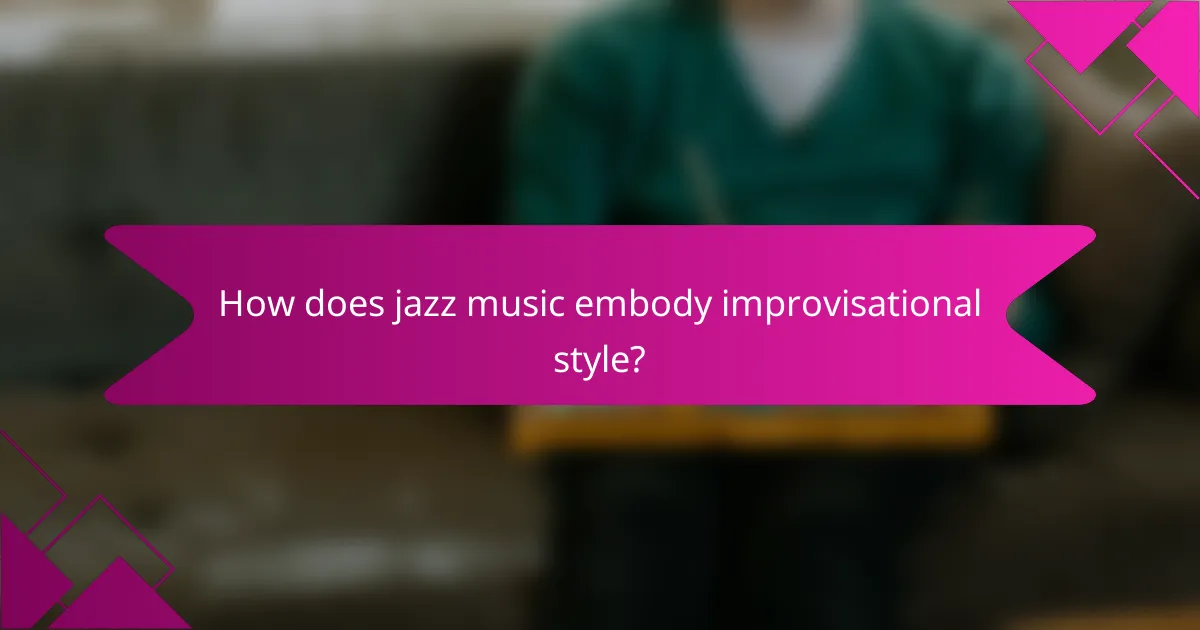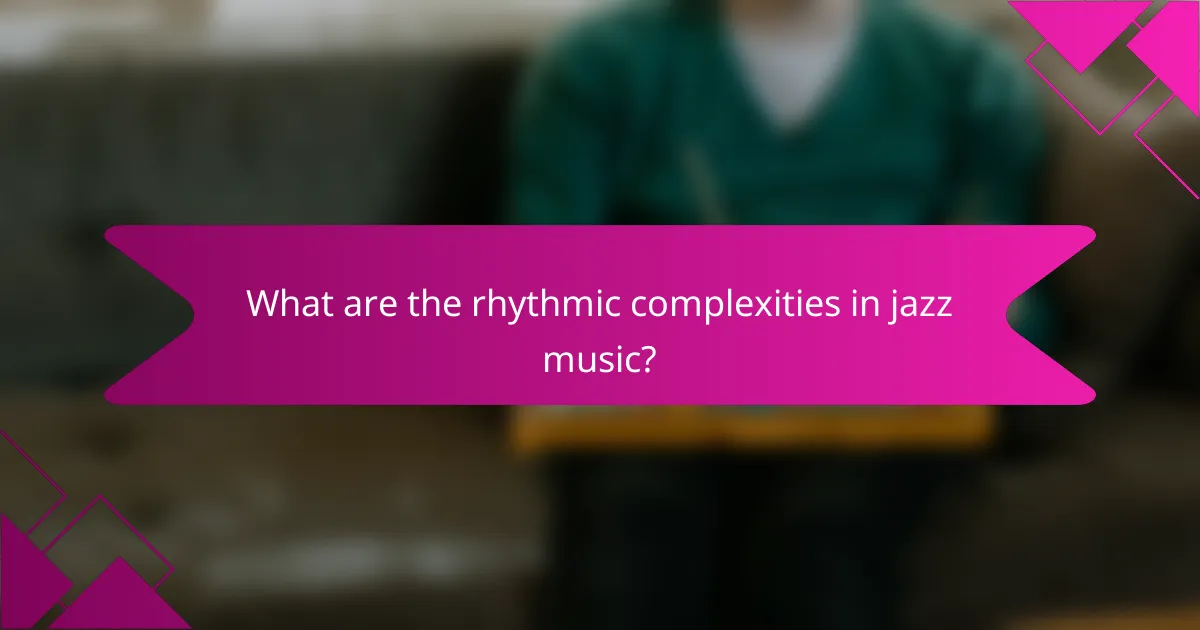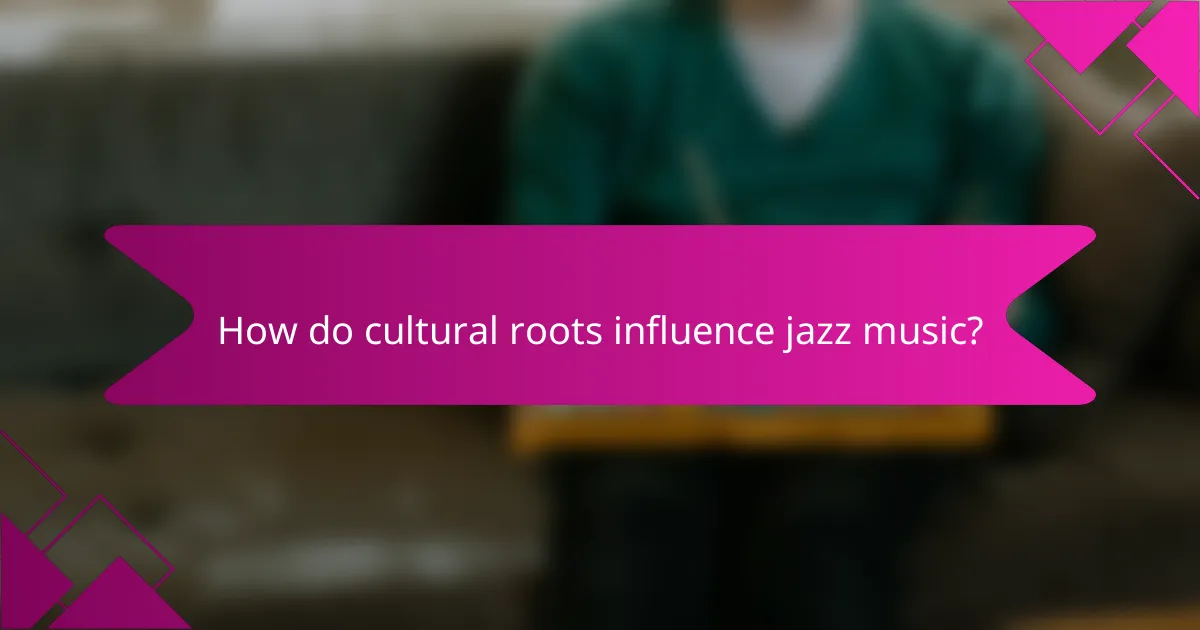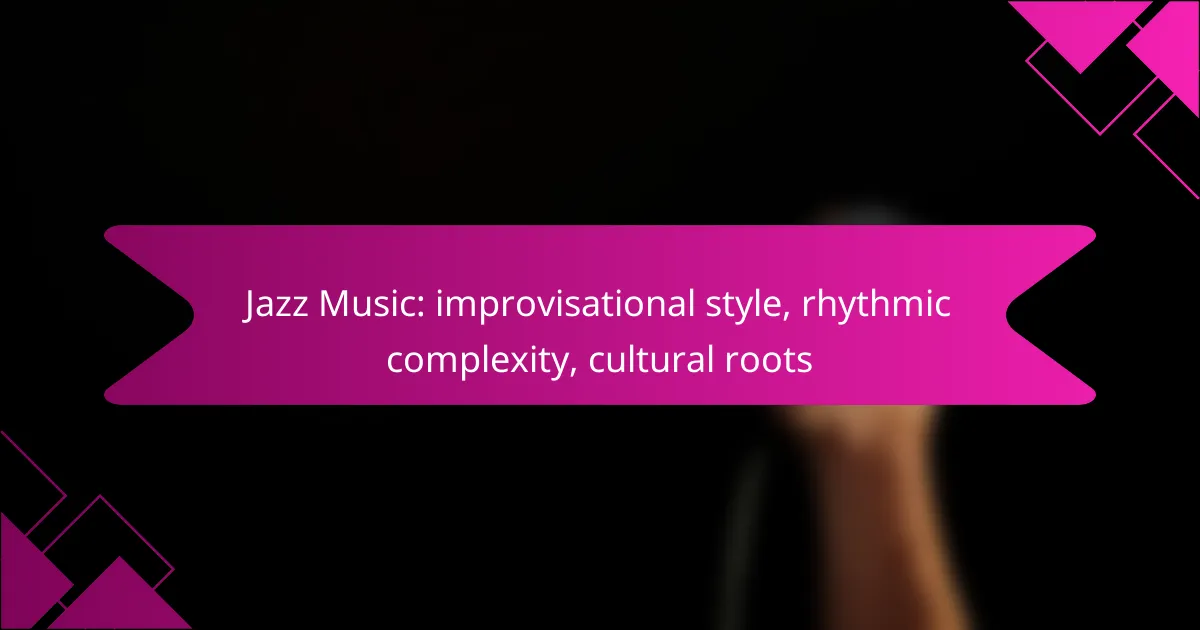Jazz music is a vibrant art form that thrives on improvisation, allowing musicians to create spontaneous and unique performances that reflect their individual expressions. Its intricate rhythmic complexities, characterized by syncopation and polyrhythms, engage listeners while showcasing the creativity of the performers. Deeply rooted in cultural heritage, jazz draws from African American traditions and various musical influences, resulting in a rich tapestry that continues to evolve and inspire.

How does jazz music embody improvisational style?
Jazz music embodies improvisational style through spontaneous creation, where musicians express themselves in real-time, often leading to unique performances. This fluidity allows for personal expression and interaction among players, making each performance distinct.
Spontaneous composition techniques
Spontaneous composition in jazz involves creating music on the spot, often relying on a framework of chords and melodies. Musicians use their knowledge of music theory and their intuition to craft solos that fit within the established structure while adding their personal flair.
Techniques such as motif development, where a musician introduces a short musical idea and elaborates on it, are common. This approach encourages creativity and keeps the performance dynamic.
Call and response patterns
Call and response is a fundamental aspect of jazz, originating from African musical traditions. In this technique, one musician (the “caller”) plays a phrase, and another musician (the “responder”) answers with a complementary phrase, creating a conversational dynamic.
This interaction fosters a sense of collaboration and spontaneity, as musicians build off each other’s ideas, enhancing the improvisational nature of the performance.
Influence of key musicians
Key musicians have significantly shaped the improvisational style of jazz. Icons like Louis Armstrong and Charlie Parker pushed the boundaries of individual expression, inspiring countless others to explore their creativity within the genre.
These musicians often introduced new techniques and approaches, such as bebop’s complex melodies and harmonies, which have become essential components of jazz improvisation.
Role of rhythm sections
The rhythm section, typically consisting of drums, bass, and piano or guitar, plays a crucial role in jazz improvisation. They provide the harmonic foundation and rhythmic support that allows soloists to experiment freely.
A strong rhythm section maintains the groove and energy of the performance, enabling soloists to take risks and explore new musical ideas without losing the overall structure.
Use of scales and modes
Jazz musicians frequently utilize various scales and modes to enhance their improvisational vocabulary. Commonly used scales include the major, minor, and blues scales, each offering different emotional qualities and tonal colors.
Modes, such as Dorian and Mixolydian, provide additional frameworks for improvisation, allowing musicians to explore different harmonic landscapes and create more complex solos. Understanding these scales and modes is essential for effective improvisation in jazz.

What are the rhythmic complexities in jazz music?
Jazz music is characterized by its intricate rhythmic complexities, which include syncopation, polyrhythms, and varied time signatures. These elements create a dynamic and engaging listening experience, allowing musicians to express creativity and spontaneity.
Syncopation and polyrhythms
Syncopation involves placing emphasis on beats or parts of beats that are typically unaccented, creating a sense of surprise and tension in the music. This technique is prevalent in jazz, where musicians often shift the expected rhythmic patterns to enhance the groove.
Polyrhythms, on the other hand, involve the simultaneous use of two or more contrasting rhythms. For example, a drummer might play a steady quarter-note pulse while a pianist plays a syncopated melody, resulting in a rich tapestry of sound that challenges traditional rhythmic expectations.
Time signatures in jazz
Jazz music frequently employs a variety of time signatures, ranging from the common 4/4 to more complex ones like 5/4 or 7/8. These unconventional time signatures allow for greater rhythmic freedom and creativity, enabling musicians to explore different feels and grooves.
When performing in unusual time signatures, it’s essential for musicians to maintain a strong sense of pulse. Practicing with a metronome or playing along with recordings can help develop the ability to navigate these complexities effectively.
Impact of swing feel
The swing feel is a defining characteristic of jazz that alters the perception of rhythm. Instead of playing notes evenly, musicians often play with a “long-short” pattern, giving the music a laid-back yet driving quality. This swing feel creates a sense of movement and excitement, making it a crucial element in jazz performance.
To master the swing feel, musicians should focus on the articulation of notes, emphasizing the off-beats while slightly delaying the downbeats. Listening to classic jazz recordings can provide valuable insights into how swing is executed and interpreted by different artists.

How do cultural roots influence jazz music?
Cultural roots play a significant role in shaping jazz music, infusing it with unique rhythms, improvisational styles, and emotional depth. The influences of African American heritage, along with other musical traditions, create a rich tapestry that defines jazz’s character and evolution.
Origins in African American communities
The origins of jazz are deeply embedded in African American communities, where it emerged as a form of expression during the late 19th and early 20th centuries. This cultural backdrop provided a fertile ground for the development of jazz, incorporating elements of African musical traditions, spirituals, and work songs.
Jazz served as a voice for social and cultural identity, allowing musicians to convey their experiences and emotions. The improvisational nature of jazz reflects the communal storytelling traditions prevalent in these communities, emphasizing creativity and personal expression.
Influence of blues and ragtime
Blues and ragtime are foundational genres that significantly influenced the development of jazz music. The blues, with its expressive melodies and themes of hardship, introduced emotional depth and a distinct rhythmic structure that became integral to jazz.
Ragtime, characterized by its syncopated rhythms and lively piano compositions, contributed to jazz’s rhythmic complexity. The combination of these styles fostered a unique sound that emphasized improvisation and interaction among musicians, setting the stage for future jazz innovations.
Role of New Orleans in jazz history
New Orleans is often regarded as the birthplace of jazz, where diverse musical influences converged in the early 20th century. The city’s vibrant cultural mix, including African, French, Spanish, and Caribbean elements, created a unique environment for jazz to flourish.
Key figures such as Louis Armstrong and Jelly Roll Morton emerged from New Orleans, helping to popularize jazz and establish its foundational elements. The city’s lively social scene, including dance halls and street performances, provided a platform for musicians to experiment and refine their craft, solidifying New Orleans’ pivotal role in jazz history.

What are the best digital products for learning jazz?
The best digital products for learning jazz include online courses, specialized apps, and streaming platforms that offer tutorials. These resources cater to various skill levels and provide practical tools for mastering jazz improvisation and understanding its rhythmic complexity.
Online courses from Berklee College of Music
Berklee College of Music offers a range of online courses specifically designed for jazz musicians. These courses cover topics such as jazz theory, improvisation techniques, and ensemble playing, making them suitable for beginners and advanced players alike.
Students can expect high-quality video lectures, interactive assignments, and feedback from experienced instructors. Courses are often self-paced, allowing learners to progress according to their schedules.
Jazz improvisation apps like iReal Pro
Apps like iReal Pro are invaluable for practicing jazz improvisation. They provide backing tracks in various styles and tempos, enabling users to jam along and develop their improvisational skills. The app allows customization of chord progressions, making it versatile for different practice needs.
Additionally, iReal Pro includes a library of jazz standards, which can help users familiarize themselves with essential tunes in the genre. This app is particularly useful for musicians looking to enhance their performance abilities in a practical, hands-on way.
Streaming platforms with jazz tutorials
Streaming platforms such as YouTube and specialized music education sites offer a wealth of jazz tutorials. These tutorials range from beginner lessons to advanced techniques, covering topics like improvisation, rhythm, and jazz history.
Many tutorials are free, making them accessible to anyone interested in learning jazz. However, premium content may provide more structured learning paths and in-depth insights from professional musicians. It’s advisable to explore different channels and find instructors whose teaching styles resonate with you.

How can jazz music be applied in modern contexts?
Jazz music can be applied in modern contexts through its integration into various forms of entertainment, its influence on contemporary music genres, and its fusion with electronic elements. These applications highlight jazz’s adaptability and enduring relevance in today’s cultural landscape.
Integration in film and media
Jazz music plays a significant role in film and media, often used to enhance emotional depth and set the tone. Classic films like “La La Land” and “Whiplash” showcase jazz’s improvisational style, creating a vibrant atmosphere that resonates with audiences. The use of jazz soundtracks can elevate storytelling, making scenes more impactful.
In television, jazz is frequently featured in shows that explore themes of creativity and urban life, such as “The Marvelous Mrs. Maisel.” This integration not only entertains but also introduces viewers to the rich cultural roots of jazz, fostering appreciation for the genre.
Influence on contemporary genres
Jazz has significantly influenced contemporary genres like hip-hop, R&B, and pop. Artists often sample jazz tracks or incorporate jazz elements, such as complex rhythms and improvisation, into their music. For example, musicians like Kamasi Washington and Robert Glasper blend jazz with modern styles, attracting new audiences and keeping the genre alive.
This cross-pollination encourages innovation, as contemporary artists experiment with jazz’s rhythmic complexity and harmonic structures. The result is a refreshing sound that honors jazz’s legacy while pushing musical boundaries.
Jazz fusion with electronic music
The fusion of jazz with electronic music has created a dynamic subgenre that appeals to a diverse audience. Artists like Flying Lotus and Thundercat combine traditional jazz instrumentation with electronic beats and production techniques, resulting in a unique soundscape. This blend allows for greater experimentation and improvisation, hallmarks of jazz.
Jazz fusion with electronic music often features live performances that emphasize spontaneity, inviting musicians to interact and respond to each other in real-time. This approach not only showcases the improvisational nature of jazz but also attracts younger listeners who appreciate the modern twist on a classic genre.

What are emerging trends in jazz music?
Emerging trends in jazz music include a blend of traditional improvisational styles with modern influences, such as electronic elements and global musical genres. These trends reflect the genre’s adaptability and its ongoing evolution in contemporary culture.
Improvisational Style
The improvisational style in jazz is becoming increasingly diverse, incorporating elements from various musical traditions. Musicians are experimenting with different scales, rhythms, and techniques, often blending genres like hip-hop, rock, and world music into their performances.
For example, artists may use looping technology to create layered sounds that enhance their improvisation. This approach allows for a richer, more textured musical experience, appealing to both traditional jazz enthusiasts and new listeners alike.
Rhythmic Complexity
Rhythmic complexity in jazz is on the rise, with musicians exploring polyrhythms and syncopation more than ever. This trend often involves the integration of complex time signatures and unconventional beats, pushing the boundaries of traditional jazz rhythms.
Many contemporary jazz ensembles now incorporate elements from genres such as Afro-Cuban and Indian music, which introduce intricate rhythms that challenge musicians and engage audiences. This complexity not only showcases technical skill but also enhances the overall listening experience.
Cultural Roots
Jazz music’s cultural roots are being revisited and celebrated, with a focus on the genre’s African American heritage. Many artists are drawing inspiration from historical influences, incorporating themes and stories that reflect social issues and cultural identity.
Festivals and events dedicated to jazz history are gaining popularity, providing platforms for musicians to honor their predecessors while innovating new sounds. This connection to cultural roots fosters a deeper appreciation for jazz as an evolving art form that remains relevant in today’s society.
